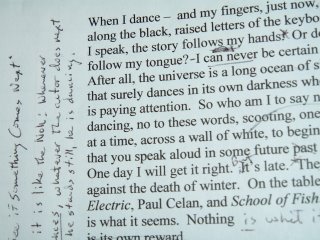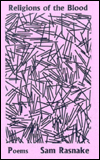in the same direction...
from my anthology of must read (a)merican poems
Frank Bidart
To the Dead
What I hope (when I hope) is that we'll
see each other again,—
. . . and again reach the VEIN
in which we loved each other . .
It existed. It existed.
There is a NIGHT within the NIGHT,—
. . . for, like the detectives (the Ritz Brothers)
in The Gorilla,
once we'd been battered by the gorilla
we searched the walls, the intricately carved
impenetrable paneling
for a button, lever, latch
that unlocks a secret door that
reveals at last the secret chambers,
CORRIDORS within WALLS,
(the disenthralling, necessary, dreamed structure
beneath the structure we see,)
that is the HOUSE within the HOUSE . . .
There is a NIGHT within the NIGHT,—
. . . there were (for example) months when I seemed only
to displease, frustrate,
disappoint you—; then, something triggered
a drunk lasting for days, and as you
slowly and shakily sobered up,
sick, throbbing with remorse and self-loathing,
insight like ashes: clung
to; useless; hated . . .
This was the viewing of the power of the waters
while the waters were asleep:—
secrets, histories of loves, betrayals, double-binds
not fit (you thought) for the light of day . . .
There is a NIGHT within the NIGHT,—
. . . for, there at times at night, still we
inhabit the secret place together . . .
Is this wisdom, or self-pity?—
The love I've known is the love of
two people staring
not at each other, but in the same direction.
*
Frank Bidart is a poet like no other. Using a range of techniques and devices, he writes with a unique voice that is raw-edged yet sympathetic in its humanity. A Bidart poem could never be mistaken for the writings of any other poet. After reading his poems, I can’t imagine them being written in another form. They are pristine copies of his singular vision.
In addition to being highly inventive with his poetry’s typography – creating many dimensions of sound, context, and meaning for the lines – he is a master of the love poem, and “To the Dead” is certainly among his best. The reality of the speaker’s tone is evident:
the VEIN
in which we loved each other . .
It existed. It existed.
The love in this poem – inescapable, undeniable – is universal in terms of sexuality, geography and time. Love is love. Bidart convinces me. Note the defining image that closes the poem: two people looking (staring) “in the same direction”. A shared vision. A staring that implies coupled determination and a surrendering to the moment. There is the ache of loneliness – “the love I’ve known”. Whether or not the emotional depth – sometimes frustrated in its secrecy (betrayals, double-binds, isolation), sometimes fulfilling (the we that inhabits the night, the chamber, the vein) – is fully shared, however, is not certain. Also, the poem, an apostrophe to the lover, is ambiguous in its refusal to confine dead to either a physical or emotional loss. Both are valid.
Bidart’s use of sound – a haunting, beautiful echo – displays the vulnerability of one’s heart: a night within the night, the house within the house, corridors, walls, the erotically charged vein, the sleeping waters. The film reference to The Gorilla underscores three prime qualities of love: untamed physicality, emotional sacrifice, and inevitable separation.
I find the speaker’s refusal to let go of hope – “still we / inhabit the secret place together” – to be compelling in its hunger. A hope to follow.
*
A link to an audio file at Poets.org of Birdat’s reading “To the Dead” –









1 comment:
Those last two stanzas kill me. Thank you!
Post a Comment